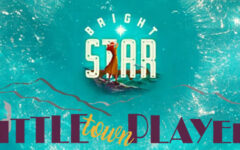 It seems that folks all over the world got quite a chuckle from the Bluegrass Beatles photo we posted last Thursday. I wish that we had some information on the original source for this photo so that we could give credit to whomever had the gumption – and wit – to massage a classic photo in this way.
It seems that folks all over the world got quite a chuckle from the Bluegrass Beatles photo we posted last Thursday. I wish that we had some information on the original source for this photo so that we could give credit to whomever had the gumption – and wit – to massage a classic photo in this way.
Among the many responses that came in about the photo was one from a British banjo playing friend of mine, Bernie Ross. He related a recent experience that touches directly on the question of “The Bluegrass Beatles,” and which I think may be of interest to anyone with a shared interest in The Beatles and bluegrass music.
The Bluegrass Beatles isn’t as far fetched as you might think. Here in the UK, there’s a guy in his sixties, from Liverpool, called Rod Davis. He plays bluegrass mandolin, banjo, guitar, and a bit of fiddle. I’ve known him vaguely, for many years, but had no idea of his story. Then, a couple of years ago, at a regular bluegrass jam in London, he mentioned to me that his CD was selling quite nicely.
“So what CD is this?” I enquired.
He explained to me that when he was a kid, he was in a band with some friends at his school. Recently, a US promoter had got the band back together and organized a tour of the US and a CD.
“Were they a big band?” I innocently asked him. “Oh, no, little more than a garage band, when I was with them,” he told me.
“So what was the band called?” I asked. “The Quarrymen,” he replied.
“Don’t be silly. You can’t call yourselves THAT! The Quarrymen was John Lennon’s band.”
“Yup, that’s right. That was me.”
Well, blimey!
The earliest photo of the Quarrymen, with John Lennon (and Rod), was taken on the day of Rod’s last gig with the band. He was replaced by Paul McCartney, who was in the audience at that same gig, and met Lennon there for the first time. You can find a picture of the gig here.
Look closely at the photo. See the bloke standing behind Lennon? Most of his instrument is hidden, but if you look carefully you’ll see that Rod Davis is playing the BANJO.
Rod remembers the last time he met John Lennon, in Liverpool around Easter 1962. “He asked me if I wanted to go to Hamburg and play drums with the Beatles. But I was halfway through my degree and my mother would have killed me if I’d given it up for ‘that Lennon,’ as he was always known in our house.”
Today, Rod says he had no pangs at missing out. “I didn’t like the music; I was more interested in folk and bluegrass. And they were trapped in hotels and couldn’t do what they wanted. Their lives were stolen from them, in many ways. I’ve had a lot of fun in my life… and no one knows about it!”
You can read Rod’s story, how he left John Lennon’s band in order to play bluegrass (yes, really), at the Quarrymen’s website.
There’s more about Lennon and the banjo connection on the BeatleNews website.
One final comment about Bernie Ross. He is a fine fellow, and a devoted student of bluegrass banjo. He is also one of the most clever and amusing people I have ever met, and he provided one of the deepest belly laughs I can ever recall when we were having a talk at the Maryland Banjo Academy some years ago. I saw him carrying a 5 lb. sack of flour through the hallway, and stopped him to find out why. It seems that he had been tasked by his local bluegrass music club in England with picking up some items during his US visit which they could offer as door prizes at their club gatherings.
Immediately, I realized how much of a treat – and a collector’s item – a bag of Martha White flour would be to a non-US bluegrass fan, though we in the southern US see them every time we enter a grocery store.
Bernie, noting my dawning recognition of the significance of his parcel, turned the situation on its head by replying with his dry, very proper delivery:
“Apparently, in the UK, we have inferior biscuits, cakes and pies.”
I nearly died. Thanks Bernie, for sending along the Beatles info.







